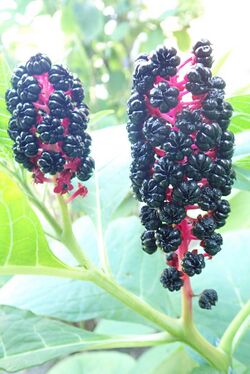Biology:Phytolacca acinosa
| Phytolacca acinosa | |
|---|---|

| |
| Scientific classification | |
| Kingdom: | Plantae |
| Clade: | Tracheophytes |
| Clade: | Angiosperms |
| Clade: | Eudicots |
| Order: | Caryophyllales |
| Family: | Phytolaccaceae |
| Genus: | Phytolacca |
| Species: | P. acinosa
|
| Binomial name | |
| Phytolacca acinosa Roxb.
| |
| Synonyms[1] | |
| |
Phytolacca acinosa, the Indian pokeweed, is a species of flowering plant in the family Phytolaccaceae.[2] It is native to temperate eastern Asia; the Himalayas, most of China, Vietnam to Japan, and has been widely introduced to Europe.[1] The species was originally described by William Roxburgh in 1814.[3][2]
Range
When the species was originally described it was considered a plant located to Nepal.[3] Currently, the plant is considered native to countries surrounding the Himalayas and introduced to large parts of Europe and parts of the United States (Wisconsin).[1]
Ecology
Indian pokeweed is a hyperaccumulator for manganese.[4][5]
Uses
As a wild food
The young shoots of Indian pokeweed are cooked and eaten by the Gurung people of western Nepal.[6] They are harvested in June and July.
Similar species (look-a-likes)
Due to overlap in diagnostic feature Phytolacca acinosa can be confused with Phytolacca americana, Phytolacca latbenia or Phytolacca polyandra.[7]
-
P. americana
-
P. polyandra
Natural products
Phytolacca acinosa is the source of four flavones,[8] four, oleanane derivatives,[9] and six triterpenoid saponins.[10]
Flavones
- Cochliophilin A
- Cochliophilin B
- 6-methoxy-7-hydroxy flavone
- 6,7-methylenedioxy-4-hydroxypeltogynan-7′-one
Triterpenoid saponins
- esculentoside A
- esculentoside B
- esculentoside C
- esculentoside D
- esculentoside H
- esculentoside T
References
- ↑ 1.0 1.1 1.2 "Phytolacca acinosa Roxb.". Board of Trustees of the Royal Botanic Gardens, Kew. http://powo.science.kew.org/taxon/urn:lsid:ipni.org:names:676329-1.
- ↑ 2.0 2.1 "Phytolacca acinosa Roxb." (in en). https://www.gbif.org/species/3084022.
- ↑ 3.0 3.1 , Wikidata Q16575978
- ↑ Xue, S. G.; Chen, Y. X.; Reeves, Roger D.; Baker, Alan J. M.; Lin, Q.; Fernando, Denise R. (2004-10-01). "Manganese uptake and accumulation by the hyperaccumulator plant Phytolacca acinosa Roxb. (Phytolaccaceae).". Environmental Pollution 131 (3): 393–399. doi:10.1016/J.ENVPOL.2004.03.011. PMID 15261402. https://www.wikidata.org/wiki/Q51644771.
- ↑ Xu, Xianghua; Shi, Jiyan; Chen, Yingxu; Chen, Xincai; Wang, Hui; Perera, Anton (2006-06-27). "Distribution and mobility of manganese in the hyperaccumulator plant Phytolacca acinosa Roxb. (Phytolaccaceae)". Plant and Soil 285 (1–2): 323–331. doi:10.1007/S11104-006-9018-2. https://www.wikidata.org/wiki/Q120682247.
- ↑ Khakurel, Dhruba; Uprety, Yadav; Łuczaj, Łukasz; Rajbhandary, Sangeeta (2021-10-21). "Foods from the wild: Local knowledge, use pattern and distribution in Western Nepal" (in en). PLOS ONE 16 (10): e0258905. doi:10.1371/journal.pone.0258905. ISSN 1932-6203. PMID 34673823.
- ↑ "Phytolacca acinosa | Manual of the Alien Plants of Belgium". http://alienplantsbelgium.be/content/phytolacca-acinosa.
- ↑ , Wikidata Q47894904
- ↑ , Wikidata Q104950731
- ↑ , Wikidata Q45204476
Wikidata ☰ Q1569312 entry
 |



